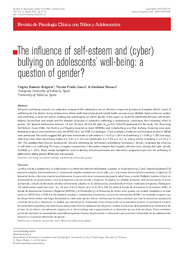Por favor, use este identificador para citar o enlazar este ítem:
https://hdl.handle.net/11000/26594Registro completo de metadatos
| Campo DC | Valor | Lengua/Idioma |
|---|---|---|
| dc.contributor.author | Romero-Reignier, Virgina | - |
| dc.contributor.author | Prado-Gascó, Vicente | - |
| dc.contributor.author | Mónaco, Estefanía | - |
| dc.date.accessioned | 2022-04-12T09:34:06Z | - |
| dc.date.available | 2022-04-12T09:34:06Z | - |
| dc.date.created | 2022-01 | - |
| dc.identifier.citation | Vol. 9, nº1 | es_ES |
| dc.identifier.issn | 2340-8340 | - |
| dc.identifier.uri | http://hdl.handle.net/11000/26594 | - |
| dc.description.abstract | Subjective well-being consists of a subjective component (life satisfaction) and an affective component (positive and negative affect). Levels well-being tend to decline during adolescence, which could have physical and mental health consequences. Multiple factors influence adolescent well-being, such as self-esteem, bullying and cyberbullying, as well as gender. In this paper, we study the relationship between self-esteem, bullying (face-to-face and virtual) and the affective dimension of subjective well-being in adolescence, considering the moderating effect gender. 797 Spanish adolescents between 14 and 18 years old (54.2% girls; Mage=15.5; SD=.68) participated in the study. The Rosenberg Self-Esteem Scale (RSE), the Positive and Negative Experience Scale (SPANE), and Cyberbullying and Peer Bullying Screening were used. Statistical analyses were performed using the SPSS 24.0, and EQS 6.4 packages. T-test, bivariate correlations and structural equations (SEM were performed. The results suggest that girls have lower levels of self-esteem (t = 4.10; p < .001) and well-being (t = 2.46; p < .05) than boys, while boys more often report being bullies (t = 2.67; p < .01) and cyberbullies (t = 2.55; p = .01), as well as victims of bullying (t = 2.16; p < .05). The variables that influence adolescents’ affective well-being are self-esteem and bullying victimization. Gender moderates the influence of self-esteem on well-being. For boys, a negative assessment of themselves impacts their negative affection more strongly than girls [χ²(df)=15.69(3); p < .001]. These results highlight the need to develop effective prevention and intervention programs to promote the well-being of adolescents, taking gender differences into account | es_ES |
| dc.format | application/pdf | es_ES |
| dc.format.extent | 8 | es_ES |
| dc.language.iso | spa | es_ES |
| dc.publisher | Universidad Miguel Hernández de Elche | es_ES |
| dc.rights | info:eu-repo/semantics/openAccess | es_ES |
| dc.rights | Attribution-NonCommercial-NoDerivatives 4.0 Internacional | * |
| dc.rights.uri | http://creativecommons.org/licenses/by-nc-nd/4.0/ | * |
| dc.subject | well-being | es_ES |
| dc.subject | self-esteem | es_ES |
| dc.subject | bullying | es_ES |
| dc.subject | cyberbullying | es_ES |
| dc.subject | adolescence | es_ES |
| dc.subject | gender | es_ES |
| dc.subject.other | CDU::1 - Filosofía y psicología::159.9 - Psicología | es_ES |
| dc.title | The influence of self-esteem and (cyber) bullying on adolescents’ well-being: a question of gender? | es_ES |
| dc.type | info:eu-repo/semantics/article | es_ES |
| dc.identifier.doi | 110.21134/rpcna.2022.09.1.4 | - |
| dc.relation.publisherversion | https://doi.org/110.21134/rpcna.2022.09.1.4 | - |

Ver/Abrir:
2119_0.pdf
221,65 kB
Adobe PDF
Compartir:
 La licencia se describe como: Atribución-NonComercial-NoDerivada 4.0 Internacional.
La licencia se describe como: Atribución-NonComercial-NoDerivada 4.0 Internacional.
.png)